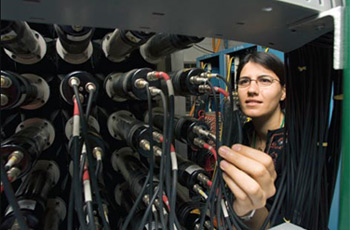 |
| Photo courtesy of MoNA |
Raising MoNA
In the olden days, farmers would travel for miles through the American countryside to help neighbors raise a barn.
A similar bustle was under way in early July on the Michigan plains, though the focus was nuclear physics instead of farming. College studentsmostly from the Midwest, but some from as far away as California—converged on the National Superconducting Cyclotron Laboratory to help the lab's graduate students and staff move the modular neutron array (MoNA).
The box-shaped array, assembled primarily by undergraduate students and used to detect neutrons, is composed of 144 plastic bars, each two meters long. It was moved to a more spacious vault as part of a major reconfiguration of the lab, which is at Michigan State University.
Each bar had to be hauled by hand, and most of the hands belonged to undergraduates.
"It was kind of like an assembly line," reflected Tova Yoast-Hull, a junior from Kenyon College in Ohio. "Except the parts don't move down the linethe people do." Pairs of students lugged each 40-pound bar down 70 meters of hallway.
Most challenging, however, were the six wires running from each bar, totaling 864 cables that had to be detached and meticulously reconnected at the proper terminals. All told, the move and reinstallation involved 27 people from 10 colleges, and took about a week.
Eddy White, a senior from the University of Notre Dame in Indiana, found the work enlightening. "Having so much hands-on experience with equipment, you really learn how it works," he said.
The lone postdoctoral researcher involved in the move, Artemis Spyrou, reminisced about the long hours she spent assembling machinery in the lab during her graduate school days in Greece, where three people managed all the equipment. "It's always fun to do teamwork," she said. In her case, there was a bonus: The only other graduate student in her group at the time, George Perdikakis, became her husband.
Annie Jia, National Superconducting Cyclotron Laboratory
A video of busy students assembling MoNA is available. Click here to see video.
Click here to download the pdf version of this article.






